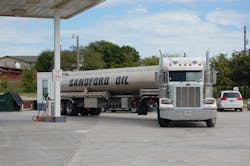The average U.S. price of diesel fuel increased 6.2 cents to reach $4.026 per gallon this week, while the cost of gasoline at the pump inched up 2.3 cents to top $3.744 per gallon on average across the country, according to data tracked by the Energy Information Administration (EIA).
Both of those price marks are now significantly higher than pump prices recorded at the same time last year, the agency noted, with diesel now 21.6 cents per gallon higher compared to the same week in 2011, while gasoline is now 16.3 cents more expensive per gallon.
U.S. gasoline consumption in the first quarter of 2012, which averaged about 8.5 million barrels per day (bbl/d), dropped 124,000 bbl/d compared with the same time last year. However, high consumption trends began to be tracked in the second quarter, the agency noted. EIA added that U.S. gasoline consumption peaked in 2007 at 9.3 million bbl/d and fell by an average of 3.2% (300,000 bbl/d) in 2008 due to the recession and high gasoline prices, which topped $4 per gallon in June and July 2008.
Higher oil prices and more demand for fuel are helping drive pump prices to record highs, according to other market metrics.
The West Texas Intermediate (WTI) benchmark for U.S. crude oil now stands at $96.63 per barrel, compared to $78 per barrel back in June, while the Brent crude oil price benchmark for international oil is up over $114.34 per barrels versus $90 per barrel back in June.
Labor Day holiday travel is also expected to spike this year, despite the higher cost of fuel, which is increasing demand for oil even further. AAA estimates that approximately 28.2 million people (85% of all holiday travelers) will make their Labor Day holiday journey by automobile; a 3.1% increase over the 27.3 million people who took to the nation's roadways in 2011.
The average distance traveled by Americans during the Labor Day holiday weekend is also expected to increase, AAA said, thus leading to more fuel usage. Average travel distance this year is expected to be 626 miles, up slightly from 2011’s average of 608 miles.
EIA noted, however, domestic crude oil production continues to increase, especially in North Dakota.
North Dakota's oil production averaged 660,000 bbl/d in June 2012, up 3% from the previous month and 71% over June 2011 volumes, the agency noted; production gains largely driven by output from the Bakken formation in the Williston Basin, which averaged 594,000 bbl/d in June 2012; an increase of 85% over the June 2011 average. The Bakken now accounts for 90% of North Dakota's total oil production, EIA said.
About the Author
Sean Kilcarr
Editor in Chief
Sean Kilcarr is a former longtime FleetOwner senior editor who wrote for the publication from 2000 to 2018. He served as editor-in-chief from 2017 to 2018.
